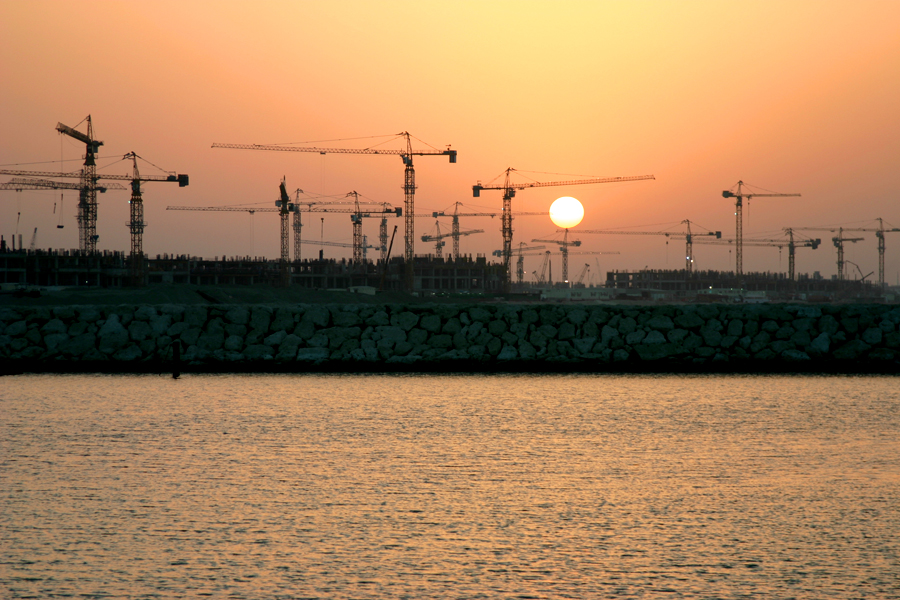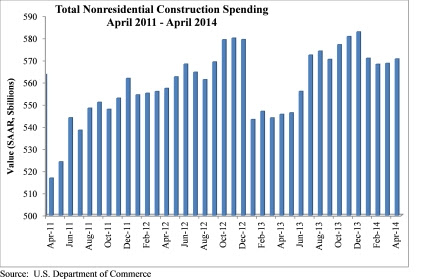Nonresidential construction spending inched up in April according to the June 2 release by the U.S. Census Bureau. This is the second consecutive month spending has increased following March’s upwardly revised spending report.
Nonresidential construction spending expanded by 0.4% on a monthly basis in April and has risen 3.9% on a year-over-year basis. Spending for the month totaled $570.6 billion on a seasonally adjusted, annualized basis.
“Unsurprisingly, nonresidential construction spending has improved with the weather,” said Associated Builders and Contractors Chief Economist Anirban Basu. “As a result of the unusually harsh winter weather, spending declines appeared large during the winter months and subsequent monthly gains have perhaps been a bit exaggerated as well. While the monthly numbers may be skewed, the year-over-year advance of 3.9% seems to realistically capture the rate of improvement in nonresidential construction spending.”
“The U.S. economy has recovered its momentum since the first quarter, suggesting that nonresidential construction’s steady recovery will remain in place,” said Basu. “Indeed, measures of business confidence have improved significantly and there are indications that capital spending is set to accelerate.”
Ten of 16 nonresidential construction subsectors posted increases in spending in April.
• Lodging construction spending is up 1.9% on a monthly basis and is up 16.9% on a year-over-year basis.
• Office-related construction spending grew by 1.7% in April and is up 20% from the same time one year ago.
• Construction spending in the transportation category expanded 3.4% on a monthly basis and has expanded 8% on an annual basis.
• Religious spending grew 1.8% for the month but is down 5.9% from the same time last year.
• Education-related construction spending gained 2.7% for the month and is up 2.9% on a year-over-year basis.
• Commercial construction spending rose 1.2% in April and is up 5.9% on a year-over-year basis.
• Sewage and waste disposal-related construction spending gained 4% for the month but has fallen 5.5% from the same time last year.
• Amusement and recreation-related construction spending expanded 4.4% on a monthly basis and is up 3.2% from the same time last year.
• Health care-related construction spending grew 0.9% for the month, but is down 6.2% on a year-over-year basis.
• Conservation and development-related construction spending expanded by 3.6% for the month and is up 19.7% on an annual basis.
Spending in six nonresidential construction subsectors declined in April.
• Spending in the water supply category fell 0.2% on the month and is down 12.8% from the same time last year.
• Manufacturing-related spending fell 1.1% on a monthly basis, but is up 6.7% on an annual basis.
• Highway and street-related construction spending fell 1.1% in April, but is up 4.8% compared to the same time last year.
• Communication construction spending was down 11.7% for the month but is up 21% from the same time one year ago.
• Public safety-related construction spending fell 0.9% on a monthly basis and has declined 12.4% on a year-over-year basis.
• Power construction spending dipped 1.2% for the month and was 1.6% lower than the same time one year prior.
Related Stories
Architects | May 2, 2024
Emerging considerations in inclusive design
Design elements that consider a diverse population of users make lives better. When it comes to wayfinding, some factors will remain consistent—including accessibility and legibility.
K-12 Schools | Apr 30, 2024
Fully electric Oregon elementary school aims for resilience with microgrid design
The River Grove Elementary School in Oregon was designed for net-zero carbon and resiliency to seismic events, storms, and wildfire. The roughly 82,000-sf school in a Portland suburb will feature a microgrid—a small-scale power grid that operates independently from the area’s electric grid.
AEC Tech | Apr 30, 2024
Lack of organizational readiness is biggest hurdle to artificial intelligence adoption
Managers of companies in the industrial sector, including construction, have bought the hype of artificial intelligence (AI) as a transformative technology, but their organizations are not ready to realize its promise, according to research from IFS, a global cloud enterprise software company. An IFS survey of 1,700 senior decision-makers found that 84% of executives anticipate massive organizational benefits from AI.
Codes and Standards | Apr 30, 2024
Updated document details methods of testing fenestration for exterior walls
The Fenestration and Glazing Industry Alliance (FGIA) updated a document serving a recommended practice for determining test methodology for laboratory and field testing of exterior wall systems. The document pertains to products covered by an AAMA standard such as curtain walls, storefronts, window walls, and sloped glazing. AAMA 501-24, Methods of Test for Exterior Walls was last updated in 2015.
MFPRO+ News | Apr 29, 2024
World’s largest 3D printer could create entire neighborhoods
The University of Maine recently unveiled the world’s largest 3D printer said to be able to create entire neighborhoods. The machine is four times larger than a preceding model that was first tested in 2019. The older model was used to create a 600 sf single-family home made of recyclable wood fiber and bio-resin materials.
K-12 Schools | Apr 29, 2024
Tomorrow's classrooms: Designing schools for the digital age
In a world where technology’s rapid pace has reshaped how we live, work, and communicate, it should be no surprise that it’s also changing the PreK-12 education landscape.
Adaptive Reuse | Apr 29, 2024
6 characteristics of a successful adaptive reuse conversion
In the continuous battle against housing shortages and the surplus of vacant buildings, developers are turning their attention to the viability of adaptive reuse for their properties.
AEC Innovators | Apr 26, 2024
National Institute of Building Sciences announces Building Innovation 2024 schedule
The National Institute of Building Sciences is hosting its annual Building Innovation conference, May 22-24 at the Capital Hilton in Washington, D.C. BI2024 brings together everyone who impacts the built environment: government agencies, contractors, the private sector, architects, scientists, and more.
Mass Timber | Apr 25, 2024
Bjarke Ingels Group designs a mass timber cube structure for the University of Kansas
Bjarke Ingels Group (BIG) and executive architect BNIM have unveiled their design for a new mass timber cube structure called the Makers’ KUbe for the University of Kansas School of Architecture & Design. A six-story, 50,000-sf building for learning and collaboration, the light-filled KUbe will house studio and teaching space, 3D-printing and robotic labs, and a ground-level cafe, all organized around a central core.
Sports and Recreational Facilities | Apr 25, 2024
How pools can positively affect communities
Clark Nexsen senior architects Jennifer Heintz and Dorothea Schulz discuss how pools can create jobs, break down barriers, and create opportunities within communities.


















